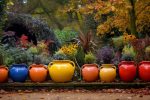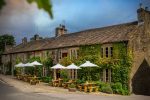Temple Newsam – The People’s House
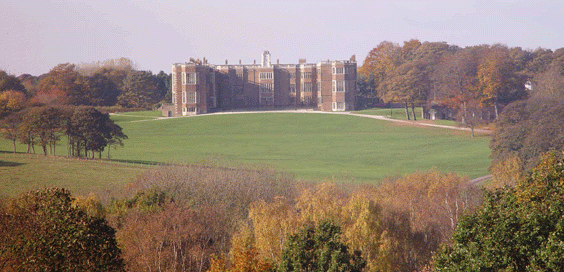
A Walk on the Wild Side
by Barney Bardsley
Temple Newsam is a place with the broad hand of history at its back. From the Tudor grandeur of the big house – first owned by Lord Darcy in 1520, and before that by the Knights Templar – to the eighteenth century elegance of its formal gardens and rolling hills (designed in 1762 by Capability Brown), this is a huge estate. Where the whiff of aristocratic entitlement lingers still in the air. Since 1922, however, Temple Newsam – all 1500 acres of it – belongs to Leeds Council: to the people themselves. It is a wonderful resource. At any time of year – come and walk here for free.
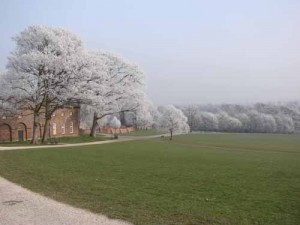 The house, the farm, the gardens are all quite familiar to me. Mostly from weekend meanderings with an adventurous toddler over a decade ago. But even plucky four-year-olds tend to conk out suddenly. They need a sticky bun, a wee, a bit of a kip. So I never got further than the rhododendrons and the curving Serpentine lakes. Then it was back to the café for refreshments. But beyond this is a huge area of woodland to explore. It is much older in parts than the cultivated gardens, and more intriguing, by far. Especially for someone who wants to get a little lost in the wild, albeit within the confines of a managed estate.
The house, the farm, the gardens are all quite familiar to me. Mostly from weekend meanderings with an adventurous toddler over a decade ago. But even plucky four-year-olds tend to conk out suddenly. They need a sticky bun, a wee, a bit of a kip. So I never got further than the rhododendrons and the curving Serpentine lakes. Then it was back to the café for refreshments. But beyond this is a huge area of woodland to explore. It is much older in parts than the cultivated gardens, and more intriguing, by far. Especially for someone who wants to get a little lost in the wild, albeit within the confines of a managed estate.
Dave Thorpe, for twenty years an estate ranger here (who now, ruefully, describes himself as Visitor Services Manager – one senses he misses his great outdoors) still seems amazed by the sense of tradition and of place. “We’ve got maps in here from 1640 and much of the woodland is the same. It is still the same shape as it was all those years ago.”
“A happy sprawl”
Intrigued, I took a step back in time for myself, wandering down the main avenue from the big house, and up the hill on the other side, to follow Temple Newsam’s own Nature Trail. First there came the dense planting of the Elm and Oak wood. The change in mood and terrain was instant and striking: from the careful, rather opulent cultivation of buildings and parkland, to the stillness and tangle of trees. Hundreds and thousands of trees. Nothing brings about an internal hush so quickly – even on a wild or windy day – as woodland. I think it has something to do with roots. Trees never move. Humans are rarely still. Each brings an energy and balance to the other. Temple Newsam’s woods – and there are thirty distinct areas to explore – are fine indeed.
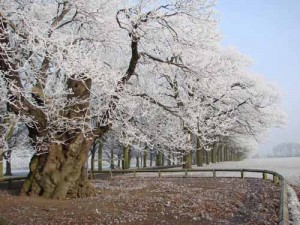 The top of the first oak wood brought a grand view of the estate – but also a disappointment, in the form of the Little Temple. This is a landscape folly designed by Capability Brown to show off the rest of the grounds to best advantage – but has been wrecked by graffiti, and is fenced off for renovation. An ugly reminder of modern day nihilism in such elegant surrounds. But once over this hill and into the wilder, wetter woodland, then magic prevailed. Lime, hornbeam, birch and beech all offered a multi-layered texture, a depth, a quietness. Plus the sense of jumble and happy sprawl that old trees naturally exude.
The top of the first oak wood brought a grand view of the estate – but also a disappointment, in the form of the Little Temple. This is a landscape folly designed by Capability Brown to show off the rest of the grounds to best advantage – but has been wrecked by graffiti, and is fenced off for renovation. An ugly reminder of modern day nihilism in such elegant surrounds. But once over this hill and into the wilder, wetter woodland, then magic prevailed. Lime, hornbeam, birch and beech all offered a multi-layered texture, a depth, a quietness. Plus the sense of jumble and happy sprawl that old trees naturally exude.
“Gorgeous sweeping pathway”
There was, throughout the trail, a discreet mix of managed and wild woods. Sign posting was minimal, but sufficient. Just as I wondered where to go next, a post popped up, with its yellow arrow pointing me through. (I still managed to get lost about halfway round – but this says more about my navigational skills than the estate’s own design.)
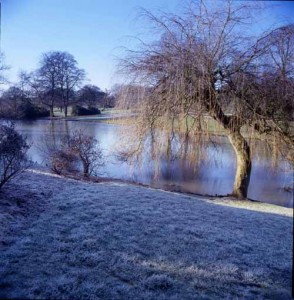 The managed woodland gave itself away by its clarity and order, the trees planted closer together, to grow straight and tall, with fewer knots in the timber. And on the far side of the main avenue – a gorgeous sweeping pathway between the trees, leading up to the mansion itself – another human intervention made itself clear. This was the coppice woodland, with hazel and birch, cut down on a twelve year rotation to provide shoots for harvesting: an ancient practise, revived here to provide both wood for timber, and a whole mini eco-system amidst the young and developing trees.
The managed woodland gave itself away by its clarity and order, the trees planted closer together, to grow straight and tall, with fewer knots in the timber. And on the far side of the main avenue – a gorgeous sweeping pathway between the trees, leading up to the mansion itself – another human intervention made itself clear. This was the coppice woodland, with hazel and birch, cut down on a twelve year rotation to provide shoots for harvesting: an ancient practise, revived here to provide both wood for timber, and a whole mini eco-system amidst the young and developing trees.
For me the oddest part of the walk was at the end, over the tops of the old mining seam, through “The Shrogs” – which means “wet woodland”, and is full of treacherous swampy undergrowth, gorse and hairy birch. Not good for someone who likes to keep her feet dry, a bit barren and gaunt – but heaven for the skylarks and yellow hammers, and they are in short supply, nationally.
“Peace at the roots of it all”
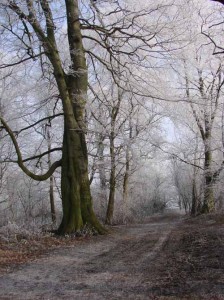 To this rather chaotic gardener and rambler, it was always going to be the sprawl of the wilder, more overgrown woodland, right in the heart of the estate, which appealed most. Shafts of sunlight piercing the trees along the Gorge, through the Wilderness Wood. Fungus gathering on rotting old tree stumps. Bracken, dying down, tripping me up. The snap of old twigs underfoot. The scent of standing water. And always this peculiar, pervasive, ancient silence – slicing through the contemporary layers of sound (the nearby motorway; the estate workers revving up some machine or other in the distance). Peace to be found at the roots of it all. At the bottom of the well of time.
To this rather chaotic gardener and rambler, it was always going to be the sprawl of the wilder, more overgrown woodland, right in the heart of the estate, which appealed most. Shafts of sunlight piercing the trees along the Gorge, through the Wilderness Wood. Fungus gathering on rotting old tree stumps. Bracken, dying down, tripping me up. The snap of old twigs underfoot. The scent of standing water. And always this peculiar, pervasive, ancient silence – slicing through the contemporary layers of sound (the nearby motorway; the estate workers revving up some machine or other in the distance). Peace to be found at the roots of it all. At the bottom of the well of time.
Temple Newsam is too big and broad and exposed in its entirety to give you the shrouded intimacy that a smaller wood or sheltered garden might. But for a bracing, bony winter’s walk – with history at your shoulder, wide spaces for the eye to rest in, and a mass of ancient vegetation at your feet – it has its own rich and singular appeal.
“A Handful of Earth” by Barney Bardsley is published by John Murray



